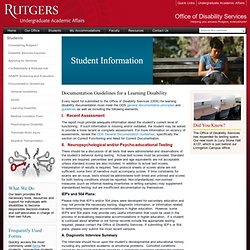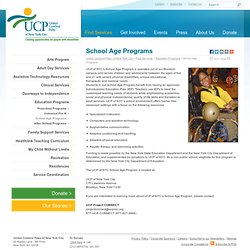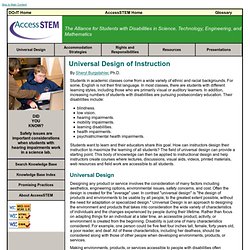

Students with Disabilities Preparing for Postsecondary Education. Reproduction and ordering information U.S.

Department of Education Arne DuncanSecretary Office for Civil Rights Russlynn Ali Assistant Secretary First published July 2002. Reprinted May 2004. U.S. September 2011 More and more high school students with disabilities are planning to continue their education in postsecondary schools, including vocational and career schools, two- and four- year colleges, and universities. The information in this pamphlet, provided by the Office for Civil Rights (OCR) in the U. OCR enforces Section 504 of the Rehabilitation Act of 1973 (Section 504) and Title II of the Americans with Disabilities Act of 1990 (Title II), which prohibit discrimination on the basis of disability. Office of Disability Services for Students — IDEA, ADA, IEP'S, and Section 504 Plans: What Happens in College? Every report for submitted to the Office of Disability Services (ODS) for learning disability documentation must meet the ODS general documentation principles and guidelines as well as including the following elements: I.

Recent Assessment The report must provide adequate information about the student’s current level of functioning. If such information is missing and/or outdated, the student may be asked to provide a more recent or complete assessment. For more information on recency of assesments, review the ODS General Documentation Guidelines, specifically the section on Current Functioning and Need for Current Documentation.
Transition_guide.pdf (application/pdf Object) Taking standardized tests – Going to College. What do you think?

Before you get started, think about how you would answer the following questions. What has been your experience with standardized tests? What test-taking strategies do you use on tests? Can you get accommodations on the ACT and SAT? Do all colleges require ACT or SAT scores for admission? Tests are part of the process Many four-year colleges and universities require standardized test scores as part of the admissions process. The most common admissions tests include the SAT Reasoning Test and the ACT test. Back to topics Sitting through the SAT The SAT is designed to measure critical thinking, mathematical reasoning and writing skills that students need to complete college-level work. The art of taking the ACT The ACT test is a general education college entrance exam that is based on what is taught in high school. Which test is best for you? It is important to talk with your teachers, guidance counselors and other students about which test may be best for you to take.
Transition. Transition Transition refers to the time when youth with disabilities leave the school system and continue on to adult life–college, vocational training, employment, and/or independent living.

This is a time when many youths “fall through the cracks” and lose services and supports that enable them to lead an independent, productive life. Planning for life after high school should be included in a student’s Individualized Educational Plan (IEP) by age 16. In fact, this is mandated by the IDEA. Resources for Youths College Scholarships and Financial AidList of available scholarships and grants for students with disabilities. Chart Your Own FutureExplains how youths can use their IEP to plan for their future after graduation. Going to CollegeA Web site about college life with a disability. Awareness of Post-Secondary Options Online tutorial designed to answer questions about educational and training options available after high school. Resources for Parents Health Care Transitions Got Transition? School Age Programs - United Cerebral Palsy of New York City. UCP of NYC's School Age Program is operated out of our Brooklyn campus, and serves children and adolescents between the ages of five and 21 with severe physical disabilities, unique educational, therapeutic and medical needs.

Students in our School Age Program benefit from having an approved Individualized Education Plan (IEP). Teachers use IEPs to meet the customized learning needs of students while emphasizing academics, social and physical independence, quality of life skills and transition to adult services. UCP of NYC’s school environment offers barrier-free classroom settings with a focus on the following resources: Specialized instruction Computers and assistive technology Augmentative communication Adaptive positioning and handling Adaptive physical education Aquatic therapy and swimming activities Funding is made possible by the New York State Education Department and the New York City Department of Education, and supplemented by donations to UCP of NYC.
SOPM-OTS2.pdf (application/pdf Object) Universal Design of Instruction. By Sheryl Burgstahler, Ph.D.

Students in academic classes come from a wide variety of ethnic and racial backgrounds. For some, English is not their first language. In most classes, there are students with different learning styles, including those who are primarily visual or auditory learners. In addition, increasing numbers of students with disabilities are pursuing postsecondary education. Their disabilities include: blindness. low vision. hearing impairments. mobility impairments. learning disabilities. health impairments. psychiatric/mental health impairments. Students want to learn and their educators share this goal. Universal Design Designing any product or service involves the consideration of many factors including aesthetics, engineering options, environmental issues, safety concerns, and cost.
Making environments, products, or services accessible to people with disabilities often benefits others.